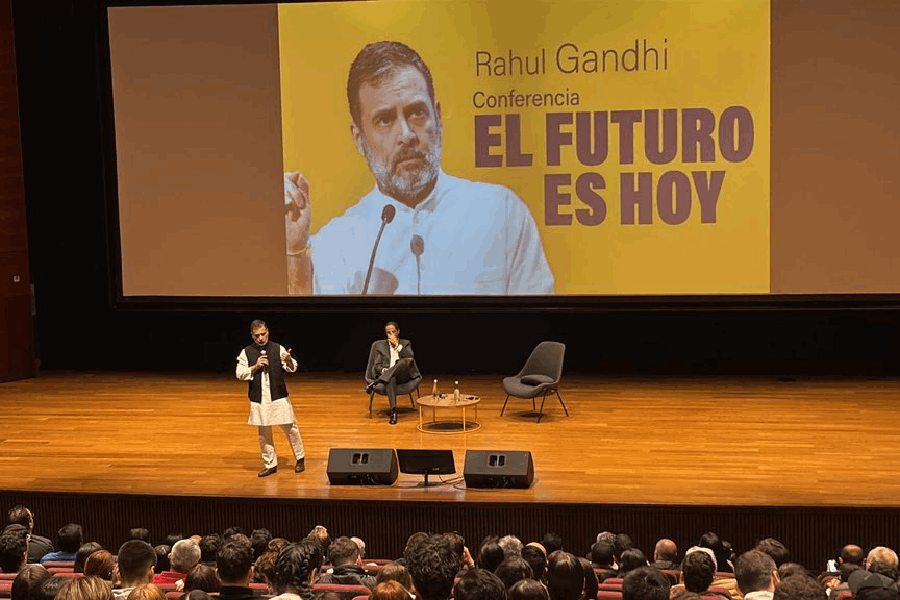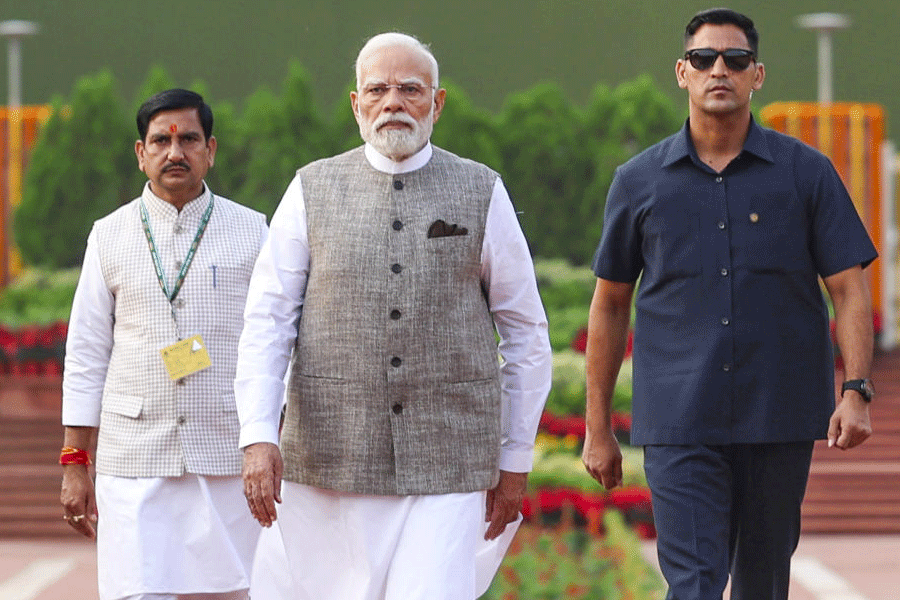 |
 |
| Buyers can exchange original paintings and digital prints by simply logging onto Chanda Chaudhary Barrai’s (above) portal The Fuschia Tree; (Top) The Giclee Print of Elephant Bull by Dane Willers from Botswana is part of the website’s |
The Indian art mart has just turned a new web page. The Fuschia Tree, a free-to-showcase online art gallery started by Hong Kong-based entrepreneur Chanda Chaudhary Barrai, has issued a new canvas call to art aficionados. They can now buy and exchange (yes, that’s right) original paintings and authentic digital prints by simply clicking their way into cyber space.
The big daddy of online auction houses in India, Saffronart, has also set the ball rolling with its new auction website that notched up sales figures of around Rs 40 crore in its summer season this year.
Making a mark is Vadehra Art Gallery that has recorded a 25 per cent increase in their online art sales since the previous year. “Technology is changing the way we conduct business,” says Arun Vadehra, director, Vadehra Art Gallery.
Also in the online bidding war is the auction house Emami Chisel Art, where Tribute to Safdar Hashmi, a painting by M.F. Husain, went under the hammer for more than $1 million early this year. Emami Chisel Art Private Limited is a tie-up between the Emami Group and Chisel Crafts, the parent company which owns Aakriti Art Gallery in Calcutta.
 |
 |
 |
| (From top) Untitled by Paritosh Sen and Untitled by Bikash Bhattacharya are works to be auctioned in November; Vikram Bachhawat’s Emami Chisel Art is using its portal to promote Gen Next, an annual exhibition of young artists |
Even Delhi Art Gallery is stepping on the gas by selling a host of original art works, lithographs, woodcuts, linocuts and etchings as well as art publications through their website.
A slew of Indian art galleries (both traditional and online) and auction houses are waking up to the reality of tapping into their keyboards in a big way and swinging art deals on their computer screens.
Also, bidding wars using the most cutting-edge technologies have been unleashed on online auction portals, allowing art buffs, collectors and investors to bid for multiple ‘lots’ of artworks simultaneously. “This is the future,” says Dinesh Vazirani, co-founder, Saffronart.
The new techno-edge of the art world is driven in part by wealthy Indians abroad who’ve always been big players in the market. For them, online art portals not only reduce the hassles of travelling across time zones when exhibitions and auctions are happening in India, but even go a step further by providing a gallery of artworks, sale details and information about the artist right at their fingertips.
“Our chief buyers are NRIs from the UK, Germany and the US. They find it easy to navigate through our portals and pick up what they like,” says Gargi Seth, COO, Indian Art Circle, a leading online art portal.
The fact is that online art portals are raking in cash. One has to simply look at the figures to feel the buzz. “From just 30 registered users in December 2000, we now have about 600. And the sales figures for global online market for Indian art have jumped from a meagre $150,000 in 2000 to $60 million this year,” says Vazirani.
The high point of the summer auction at Saffronart was a Subodh Gupta Untitled selling for Rs 5.7 crore. This is the highest price achieved by him at an auction.
In fact, Saffronart has undergone a huge leap forward by introducing new technology on its auction platform this year. “From static, it’s now dynamic,” says Vazirani. The new technology ensures that you do not have to refresh the website page continuously for fresh updates on the bidding process. The bidding values are automatically updated in real time so that you know exactly where you stand with respect to your fellow bidder.
 |
 |
 |
| (From top) Untitled by Francis Newton Souza; Untitled by J Swaminathan — part of the top five lots from the June 2008 auction at Saffronart; Dinesh Vazirani, co-founder, Saffronart |
Registered users can also bid on multiple auction ‘lots’ at the same time and the highly interactive and user-friendly nature of the portal allows the bidder to switch back and forth while bidding for various lots simultaneously.
There’s also a new ‘Browse and buy’ section at Saffronart that offers detailed information of particular works of art available for sale including distinct visualisation tools enabling the buyer to see an improved quality of the image.
The Fuschia Tree too has come up with a host of innovative provisions in their portal to stay ahead of the pack. There’s a resale assurance guarantee so that an online buyer can exchange his print for an original artwork by paying more or vice versa.
The portal has a specialised panel of curators for authenticating the products that are up for sale. This ensures that the collector gets the original value, if not more, for his object of purchase when he decides to exchange it for another piece. “Every artwork on our website is screened by curators who ensure that the quality of art we place on our website is world class,” says Barrai, CEO and founder, The Fuschia Tree.
What’s more? The website also has most of its international art in Giclee (or digital) Prints, that uses advanced imaging technology. In this technique, the printer squirts the ink on the canvas imparting it with a texture and depth that are not available in regular artwork prints. Some of the significant Giclee Prints in their collection include Jose De La Barra’s Relax (Peru), Andre Raputo’s Creek (Kazakhstan) and Dane Willers’ Elephant Bull (Botswana) among others.
To create a user-friendly interface for its buyers, The Fuschia Tree also has a virtual toolkit with options like ‘My Wishlist’ that helps users to select, store and manage artwork that they see on the portal.
Subsequently the portal will revert with information about artworks in its collection that match these specifications.
Apart from this, the portal will also have art merchandise like notebooks and handbags that can be purchased online and from retail stores in future. Projects in the pipeline include hosting an art and design show in the Capital called Mint Green that will showcase Indian and international art from Russia, Peru, Botswana, Africa, Pakistan and Thailand.
 |
 |
| (From top) Still Life — Adaptations in 20th century Indian Art by Roobina Karode; Haren Das — The End of Toil Prints (1945-1990) by Paula Sengupta and Roobina Karode are some of the new titles displayed on the Delhi Art Gallery website |
Even Emami Chisel Art Private Limited is using their portal to promote Gen Next, an annual exhibition of their gallery wing called Aakriti that showcases works of contemporary artists below the age of 40. The unique selection process of Gen Next is what makes it stand out in the herd.
Once the young artist, aspiring to exhibit his work at Gen Next, submits his work and résumé in an electronic data storage format, identifying details including the name and résumé is removed before the selection process begins. The selection is done by an informed panel consisting of art critics, historians, painters and art teachers.
When the number of entries is narrowed down to 100, Vikram Bachhawat, director, Aakriti Art Gallery steps in. He chooses the final group of 40 participants for the actual exhibition. “It is through our portal that the word has spread. For this year, we have been able to select 11 foreign participants for the show from countries like France, Canada, Italy and the US. In fact, six of them are even travelling to Calcutta for the show,” says Bachhawat.
Even traditional galleries are quite upbeat about their online presence. Delhi Art Gallery is pushing art publications off its rack in a big way along with original artworks and prints (lithographs, woodcuts, linocuts and etchings). Significant titles listed on their website include Wings of Fire — P. Khemraj Four Decades, Haren Das —The End of Toil Prints and so on.
 |
 |
 |
| (From top ) 2 day in Saket by Atul Kasbekar and Liquid Memory-C&D by Baiju Parthan are some of the works displayed on the Vadehra Art Gallery website; Arun Vadehra’s Vadehra Art Gallery has recorded a 25 per cent increase in online art sales since the previous year; Pix by Rupinder Sharma |
“We have almost 2,000 artworks displayed in our website and our online sales contribute to about 50 per cent of our total sales figures,” says Ashish Anand, director, Delhi Art Gallery. In fact there has been an increase of 20 per cent in their online transactions since last year.
Other galleries too are making smaller splashes on the online art scene. Arun Vadehra marvels at what he calls the ‘difference in technology,’ and says though the online sales of Vadehra Art Gallery account for almost five per cent of his total art retail, the hike from the previous year is 25 per cent. “And that is quite a significant figure,” he adds.
He gives the most basic example of how sale transactions are being expedited through technology. Recently, he was able to sell an artwork to a Singaporean businessman by sending its high resolution image to his wife over the Internet.
And it isn’t only the buyers who are having a field day trawling the websites and making decisions worth millions of dollars in a flash. The artists are getting a piece of the pie too. In fact, the colour conjurors are a happy lot at The Fuschia Tree as well. The portal is based on the free-to-showcase model. So, unlike brick-and-mortar exhibitions, nothing is charged from the artist to display his images online.
Smaller online galleries like Indian Art Circle have even introduced new features that enable artists from whom the portal is sourcing its exhibits to manage their collections online. “We even give artists the user names and passwords so that they can arrange their collections online, removing images that have already been sold and uploading new ones,” says Seth.
The website even permits painters to upload images from their oeuvre that are not available for sale so that connoisseurs logging in can have a comprehensive idea about their work.
Even buyers have a lot to gain from this improved interface. There are provisions of sending e-broadcasts (a web link that has a compilation of images meeting user specifications) to potential customers.
It is evident that most Indian art galleries and auction houses have several aces up their sleeves to woo the global art connoisseur. But everyone is playing their cards close to their chests. It will take a few years for traditional gallery owners to become converts. As Arun Vadehra puts it: “Brick and mortar galleries are still important in the art world.” The change brought about by technology will be gradual but inevitable. But until then, no one is complaining.











